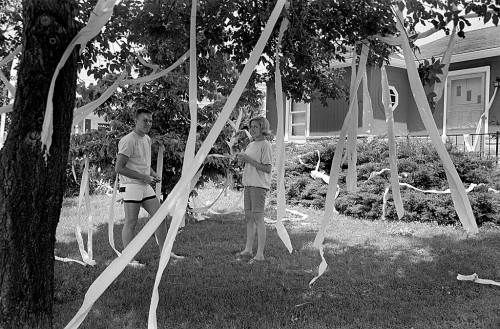 Way back in the spring, I received this rather long piece on Toilet Paper Wars in Cape. I held on to it, knowing that I would eventually find some photos to illustrate it. Reversing my normal style, I’ll put my comments in italic type so you can tell his words from mine. The writer is someone who contributes regularly, but under aliases. (I’d rather have real names, but this character has some viewpoints that are worth reading, even if I can’t identify him/her.) I also can’t tell you who the kids are in the photo, but I’m sure one of you will know them.
Way back in the spring, I received this rather long piece on Toilet Paper Wars in Cape. I held on to it, knowing that I would eventually find some photos to illustrate it. Reversing my normal style, I’ll put my comments in italic type so you can tell his words from mine. The writer is someone who contributes regularly, but under aliases. (I’d rather have real names, but this character has some viewpoints that are worth reading, even if I can’t identify him/her.) I also can’t tell you who the kids are in the photo, but I’m sure one of you will know them.
The Bun Wad War
By Anon
Beginning the Winter of 1963-64, before the first Central Vietnam casualty, Cape Girardeau became the battleground in a very different kind of war. For years the town’s leafless trees had frequently worn a weekend finery of white streamers left by roving bands of anonymous underclassmen not yet of driving age (and, therefore, at the two-foot end of the dating pool.)
That Fall a particularly active group of Freshmen that included Brad Leyhe was well known to have perpetrated a goodly number of raids, sometimes calling on as many as four houses in an evening.
[Editor’s note: I cannot verify any of the information my anonymous source has provided, so, please, Brad, don’t come looking for ME.]
Upperclassmen provided wheels
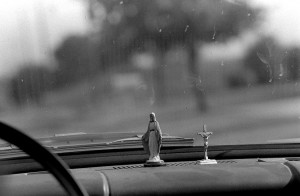 Such cavalry-like tactics were possible because of the relationship between carless underclassmen and occasionally dateless upperclassmen who, with nothing better to do, often honored such behavior by transporting the miscreants around town – for gas money, of course. This tradition, stretching back to the advent of the auto, helped bind Centralites into a more cohesive community.
Such cavalry-like tactics were possible because of the relationship between carless underclassmen and occasionally dateless upperclassmen who, with nothing better to do, often honored such behavior by transporting the miscreants around town – for gas money, of course. This tradition, stretching back to the advent of the auto, helped bind Centralites into a more cohesive community.
[Editor’s note: I am reasonably sure this vehicle was NOT involved in these escapades, but I’ve been looking for an excuse to use the photo for a long time.]
House left unguarded
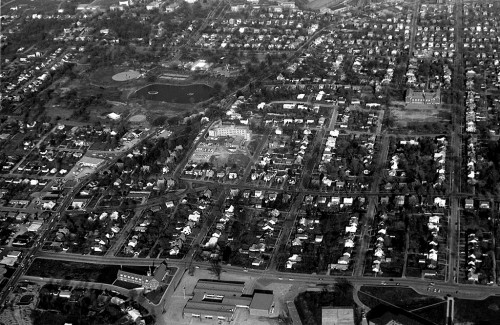 By Thanksgiving 1963 the Leyhe band had developed quite a reputation as well as a number of revenge-seekers. During the week preceding, spies had learned that the Leyhes were leaving for a long weekend, their house on the back side of Capaha Park unguarded.
By Thanksgiving 1963 the Leyhe band had developed quite a reputation as well as a number of revenge-seekers. During the week preceding, spies had learned that the Leyhes were leaving for a long weekend, their house on the back side of Capaha Park unguarded.
[Editor’s note: I have no idea where the Leyhes home is located, but this is a shot that shows Capaha Park in 1964.]
Black Friday evening an aggressive assault was launched leaving in its wake the effects of nearly two dozen toilet paper rolls and paraffin, not soap, covered screens (The difference being that while the latter washed out, the former had to be steamed off.) A second group mounted a follow-up mission Saturday night adding 20 or so additional rolls to those already in place. Worse, a fine rain fell early Sunday, plastering the paper to the bark and weakening the tensile strength of the streamers making them impossible to pull down. The family returned to a catastrophe of historic proportions, the remnants of which were to be seen for weeks afterward.
Central’s halls abuzz
Monday, Central’s halls were abuzz, as seemingly everyone had witnessed what the weekend had wrought. While opinions differed on the appropriateness of the response (hits to that time averaged 10 rolls), most recognized it as a harbinger of the significant escalation in the tenor of tee-peeing to come.
True, there had been the attempted Dearmont Quadrangle bombing a year or so earlier, but those were SEMO students with a plane. Not only did they miss the target, the outcome was a almost unrecognizable to a TP traditionalist. And, they got caught. While SEMO was to play a major part in the events of the next twelve months, it was the Thanksgiving weekend raid that sparked the most vicious period of paper sabotage Cape had ever seen.
Officer Ravenstein frustrated
For the rest of that winter, officer Ravenstein and his colleagues were stretched thin as parent frustration mounted with the number, sophistication and severity of the incidents. Twenty then 30 rolls per house became the norm in the tit for tat of the escalating aggression. Syrup covered steps and burning brown bags were de rigor as the guerrillas’ numbers swelled to accomplish the forays in the limited time before police arrival. Whether the cops weren’t trying or the hamburger, an addition to every well-planned expedition, did indeed distract the dogs, no one’s parents got the late-night call to pick their kid up at the old police station that winter.
[Editor’s note: This photo of Officer Ravenstein has nothing to do with the story, but I wanted to run it anyway.]
As the months progressed, money became a key issue. Rolling was not an inexpensive weekend outing. At the time the minimum wage was about $1.30 per hour. A gallon of gas was less than 20 cents. A Wimpy burger and a cherry vanilla 7-Up cost a dime. When most late-night visits to Cape Rock were preceded with a stop at a favored drive-in (Wimpy’s, Pfisters or A&W) at a cost of less than a dollar, the $3 for materials (30 rolls at $.10 per roll) plus gas for the driver meant the Freshmen were paying more and getting less. Add to that the additional weaponry of syrup and soap and it was indeed a costly expedition. Things got so that it was impossible to find toilet paper in any public restroom, and many WWII veterans-turned-fathers were demanding to know who was wasting all of the bun wad at home.
Secret stash behind Houck Field
As allowances neared the breaking point, it became known that one gang had amassed a 100+ roll cache of purloined paper from SEMO. This revelation struck dread in rival bands, knowing that, if true, a superpower was in the making. After a few days and not insignificant bribes, the location of the secret warehouse was revealed to be the old seismograph building in the Home of the Birds. On a wet Saturday in early Spring rivals relocated the arms to an equally obscure site behind Houck Field.
Late Spring brought the end of the papering season, the new leaves blocking and hiding streamers. A truce of sorts ensued as the off-campus focus shifted to the soon to be opened Teen Age Club at its second floor lodgings down from the Courthouse. Nevertheless, preparations for the anticipated renewal of hostilities when the leaves disappeared proceeded apace. Many were the raids on unguarded SEMO store rooms containing the treasured 100-count cartons of industrial strength toilet paper.
Resident Assistants would give chase
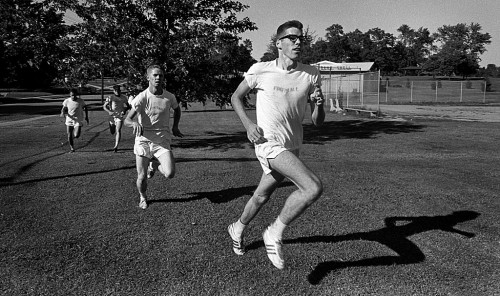 Occasionally some overzealous Towers RA would give chase, but these short-time visitors were no match for townies who had spent their kindergarten years with Miss Gross and a not insignificant portion of their youth mastering campus shortcuts. At summer’s end the Houck arsenal contained over 2,000 rolls awaiting the call to arms. [Editor’s note: these fellows are also irrelevant to the story, but I needed a running picture.]
Occasionally some overzealous Towers RA would give chase, but these short-time visitors were no match for townies who had spent their kindergarten years with Miss Gross and a not insignificant portion of their youth mastering campus shortcuts. At summer’s end the Houck arsenal contained over 2,000 rolls awaiting the call to arms. [Editor’s note: these fellows are also irrelevant to the story, but I needed a running picture.]
In September 1964 something – or more accurately 375 somethings – were missing at Central. Gone were the Freshmen, retained at the new Junior High, leaving the now Sophomores of the Class of ’67 again at the bottom of the high school heap. But, things were not as bleak as they might have been for the underclassmen.
Teen Age Club a success
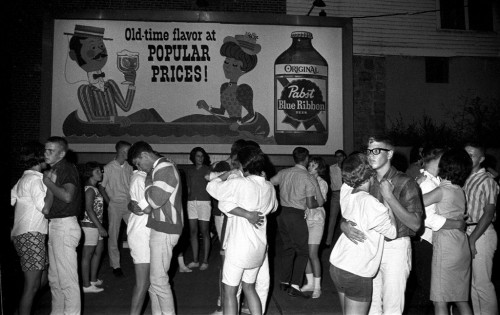 Over the summer the Teen Age Club had exceeded everyone’s expectations, wearing out its original Themis Street digs, forcing a move to location number 2 (of at least 4) to the small industrial park behind Central. Not since the Mary Ann [roller rink] had parents of teenagers a place that would stand nominally in loco parenti. TAC offered a cheap, acceptable option to the risks of injury and capture by angry fathers and Cape police.
Over the summer the Teen Age Club had exceeded everyone’s expectations, wearing out its original Themis Street digs, forcing a move to location number 2 (of at least 4) to the small industrial park behind Central. Not since the Mary Ann [roller rink] had parents of teenagers a place that would stand nominally in loco parenti. TAC offered a cheap, acceptable option to the risks of injury and capture by angry fathers and Cape police.
[Editor’s note: TAC was so popular that the building inspector was afraid the gyrating teens were going to cause the floor to collapse, so the dance was moved to a bank parking lot.]
Still, in late October when fires flared in the gutters and Cape was awash with the aroma of burning leaves, white streamers reappeared with a vengeance. But, early in the renewed hostilities campaigners received their first major blow.
Father tipped off
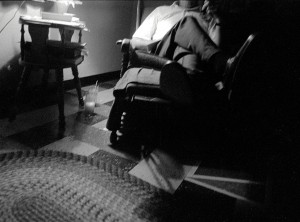 Ironically, it came not from the police or irate targets, but the father of one of the more daring organizers. [Editor’s note: that’s actually my dad relaxing in his recliner in our basement.]
Ironically, it came not from the police or irate targets, but the father of one of the more daring organizers. [Editor’s note: that’s actually my dad relaxing in his recliner in our basement.]
Acting on a warning from a double agent, the Stahly Brothers, waiting in ambush, inadvertently tipped him off. What followed is best unrecorded. However, with the son laid low, many of the feuds that had fueled the fighting faded. For the few remaining fanatics, a new enemy had to be conjured, and what better than the students at Notre Dame.
Notre Dame the new target
Despite their close proximity, traditionally there had been little interaction between the two student bodies. Just how much of this related to past religious prejudice is beyond the scope.
Things were changing. TAC offered a neutral ground for prolonged contact beyond that of basketball field house or a cross-car conversation at a drive-ins. Familiarity may breed contempt, but first it brings recognition and romance, both still a ways away as the cold winds of November swirled into Cape.
 Planning had already begun for a massive raid on Notre Dame itself. The school was scouted, targets plotted, escape routes planned and for weekend traffic patterns/police patrols studied. No detail was omitted.
Planning had already begun for a massive raid on Notre Dame itself. The school was scouted, targets plotted, escape routes planned and for weekend traffic patterns/police patrols studied. No detail was omitted.
Given ND’s relative isolation, it was estimated that there would be about an hour of uninterrupted on-site time. Experience indicated that in 60 minutes a well-practiced team of 6 could put 400 rolls on target. Extra laundry bags, the secret to moving TP invisibly, were acquired and the date, coinciding with a covering dance at Central, chosen.
At the gym that evening two team members bowed out, but an out-of-town guest joined, making the strike force five. The decision was made to proceed.
The plan went into the toilet
It was a dark night, and things did not go as planned. First there was difficulty in locating the bags pre-positioned that afternoon. Then it was discovered that full roll thrown to the school roof tended to keep going, pulling the streamer up after it. The adjustment required the trees close to the convent be covered first (increasing the risk of discovery), and the then the almost spent rolls be taken up to the school building. Shrubs were wrapped and confetti sown into the lawn. Things were proceeding, but well behind schedule, when the lookout radioed over the walkie-talkie, “Cops.”
The team escaped without difficulty using the pre-determined routes. Within half an hour, all reported to the rally point. There it was discovered that some of the laundry bags were left behind. And, on those bags were identification markings.
It was Midnight when the bag boy slowly crept through the cemetery bound for the temporary ammo depot. It had been an hour since the alarm, and the police had never before stayed longer than twenty minutes. So it was nearly wet pants when one jumped from behind a gravestone demanding a reason for the trespass.
Payne Muir wasn’t happy
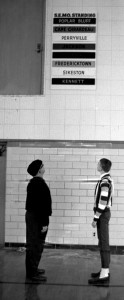 The fraternity initiation story sounded good until the now perp entered the squad wagon. There sat Central coach Payne Muir, a nearby resident, fuming about his slit tires. It was he who had called in the alarm, and it was that on which the investigation had focused until the Sisters notified the officers of the school’s desecration. And, there in the back-end were the laundry bags.
The fraternity initiation story sounded good until the now perp entered the squad wagon. There sat Central coach Payne Muir, a nearby resident, fuming about his slit tires. It was he who had called in the alarm, and it was that on which the investigation had focused until the Sisters notified the officers of the school’s desecration. And, there in the back-end were the laundry bags.
The subsequent juvenile hearing was unremarkable until one of the defendants, when asked by the judge, “Why?” responded, “There’s a certain beauty to it.” To which the judge retorted, “Judge Statler (the circuit court judge with ND connections) may not think so. The next time this happens it goes before him (meaning trial as an adult).”
Thus ended the year of living dangerously. Tee-Peeing on a large scale became almost a lost art as Judge Statler’s dictum reverberated around town. As for the devastation at Notre Dame, no one ever saw it all. What the Sisters didn’t clean-up that evening, the usual cast of Notre Dame detentioners did at 7:30 the following morning. Not even Kenny Steinhoff got a photo. [Editor’s note: True, unfortunately.]
Post script – In 1989 a crew demolishing the old picnic pavilion behind Houck’s Rocks found nearly 700 rolls of old toilet paper stashed in the long locked cabinets. They were disposed of still in their wrappers.

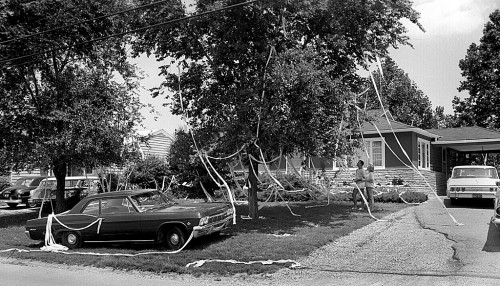
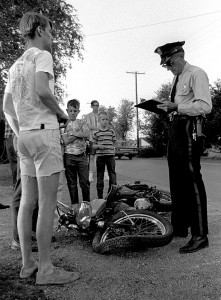
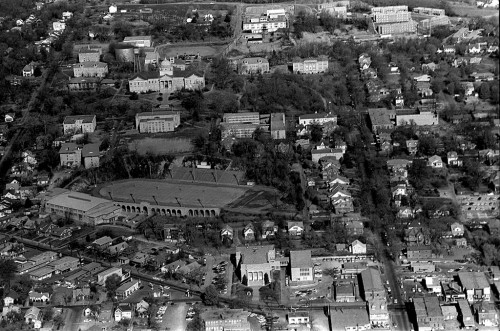
10 roll packs of toilet paper could be purchased at Cousin Fred’s and would roll a house very nicely….at least that is what I was told.
Ahh, that’s a sad end to the arsenal.
This story brings back fond memories of my own TPing days. If only the Cape TP troops had realized that sticking to pure TP–without the brown bags, soap and syrup–would have brought less police interest!
The joy of a perfectly tossed roll draping over a high branch and then cascading perfectly back down is a fond teenage memory. Not so fond, though, was my Dad’s wrath when the large oak trees in our yard were struck. My older sister and I were sentenced to clean-up, not just of our trees but any other decorated trees Dad noticed in the future. His theory was that we surely had been part of the problem, so we would everafter be part of the solution. We were convicted by our own trees for which we had not tossed a single roll.
Wonderful, wonderful story, Ken, and very well-written in true adventure, tongue-in-cheek style! I enjoyed this very much and applaud you for using it! Your totally irrelevant photos added a delightfully nonsequitor bit of humor and kept the length of the piece from getting unwieldy. The whole idea is a prankster lover’s dream come true!
There can be no doubt that the anonymous author was one of the perpetrators of the adventure. He/she just had too much inside information!
Thanks to both of you for a GOOD LAUGH!!!!
I wasn’t one of the “cool” kids, so our trees were left unscathed. Knowing Dad, he would have welcomed a festooning of free toilet paper. He’d have had us boys out re-rolling it for family consumption.
I vaguely remember the sad story of a girl who equated tee-peeing, teepeeing, TPing (pick your favorite spelling) with popularity. She got caught doing her own house and was made an object of scorn and ridicule for the rest of her high school career. Kids could be mean, even then.
First two pictures are my husbands house on Perryville Road. And in the yard is his brother Steve Robert and girlfriend (now wife) Mary Wright. As for the Central-Notre Dame connection The Robert boys went to ND and Mary and I were CHS girls. As always, Ken, thanks for the memories!! And I did not do the papering! Not to say I never did any but not there…..
Well 2 things, first I remember the first time I got TPed (toliet papered). it was a strange feeling explaining to your parents and knowing you were part of the “in” group. Also nice picture of my dad investigating a bike accident. thanks always nice to revisit life in Cape
Bob,
I’ve been looking for an excuse to run that picture for some time, and this looked as good a time as any.
I don’t know how bad the rider was hurt. He must have been swooped and scooped by the time I got there. Don Kremer, the coroner, showed up after I did, but he might have been chasing the same Missourian $5 I was.
Confidentially, your anon writer is [Name redacted] class of 67. I was with him on all of those escapades, and he is the only person that would know all those details. I suggest you let him know that you know his initials. JTL. Thanks have some fun with this !
[Editor’s note: Joe, whose name is mentioned in the posting, ratted out his buddy. I wasn’t sure if “confidentially” meant that he really didn’t want to post this publicly or not, so I’ll hide the name of the person he’s trying to throw under the bus until I find out if he wants to publish it or not.]
For anyone growing up in the midwest in the 60s, this story (and photos – relevant or not) is a gem. Thanks to Ken and he who must not be named.
TPing (also called “rolling” a house) was a favorite way to get back back at xboyfriends & boyfriend-stealing girls alike. Also, a group of us (don’t remember who) after Red Dagger play practice stuffed a teacher’s car with wadded up newspaper from the back floor board to the ceiling, then wrapped entire car in TP. Almost as much fun as the first real senior skip day (class of ’65). Loved those 60’s! Up north, kids TP a house when the resident kid makes State playoffs or other sports feat. (t’s considered a badge of honor).
Anola
It’s nice to finally know who did this masterful job of newspaper stuffing.
Some member of the class of 1967 were also very adept at “mooning”.
Van,
I’m sorry / happy to say that I don’t have any photos of the Class of 1967 mooning.
Of course, I keep running into lots of stuff I would have sworn I had never shot, so…
The correct term is “TJ”, as in: Ken’s home was TP’ed last night…
I understand that some of the “wheel men” drove the crews to the sites and then parked some distance away on another street awaiting the escapees in a dark spot away from street lights. Oftimes they wanted to be involved, but not to the extent that they might be directly connected. It is also my understanding that the most sophisticated groups had walkie talkies with the wheel man listening to a scanner for police calls.
There was one unrelated group of people that got their kicks driving a parent’s Cadillac, with cigarette lighters in all of the doors, seeking out the photocells that controlled street lights around town. They would use portable spotlights that plug into the cigarette lighters to train on the photocells, turning out street lights all over town. The car would have been quite a spectacle viewed from afar, with four spotlights coming from the four windows.
This tactic may have been used to extinguish street lights in a TP target’s vicinity.
I know whos house that was. Steve and Norman Robert. You might know Janet Robert, Norman’s wife. She has been a city official for years. It was located on Perryville Rd. Just two houses from where I grew up.
This is Brad Leyhe, the hero of this screed. A friend told me this was up. This is a revelation that 70-year olds are still very concerned about adolescent nonsense in Cape Girardeau in the early 1960s. It was pretty stupid; I agree.
First and foremost, too much, well virtually all of this is simple fiction. In those bleak days, Tucker often had ambitions or fantasies about “rolling” as we called it, or bags on fire. No arson for this kid. Tucker was never part of my merry band. Let’s just leave it like this…those that know aren’t telling and those telling don’t know. I see some names in this string that do know something, and some a lot.
I never sought to be a legend. I was entertaining myself in a small Missouri town, stirring things up a bit. I note an oblique reference to perhaps my father. I really respected and liked Tucker’s father, a true gentleman, charming and classy, an owner of Buckner Ragsdale…the best men’s store for a long time. I know Tucker will agree with this. They were a fine family.
Finally, I wish you had some real photos of my work…the opulence of the displays was breath-taking, not these shabby jobs displayed. My team took pride and time in our work. Great memories for us.
Thanks for posting this. It is a great creative work. Hey Tucker, you used my full name…why not own it? Afraid I will come and roll your house, wherever you are? No paraffin I promise…just good old Ivory Soap, the vandal’s preferred choice. You get amnesty if you are in a nursing home.
Love it, thank you Tucker.
Brad
I’m sorry I don’t have any photos of your better work. I wasn’t exactly invited to go along on those escapades.
Definitely one of your best posts, Ken. Brought back lots of memories (Wimpy’s, TAC at the bank parking lot, etc.) and lots of laughs. Thanks and keep em coming!